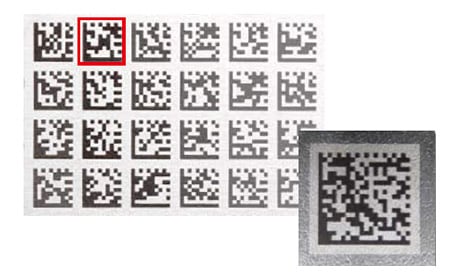

- Keyence laser marker programming how to#
- Keyence laser marker programming mod#
- Keyence laser marker programming serial#
- Keyence laser marker programming verification#
The data from this result can be output via I/O or data communication to signify a Good or No Good mark.
Keyence laser marker programming verification#
Verification and grading of a marked 2D Code can be performed via the laser markers built-in camera. The MD-X Series laser marker has a built in 2D code reader and verifier to accurately mark and check 2D codes without using a separate device. KEYENCE manufactures both laser markers and code readers, focusing their attention on providing systems for tracking and traceability. Years of KEYENCE laser development in solid state and fiber oscillators has led to the invention of the HYBRID oscillator powering our new MD-X Series laser marker. This unique laser oscillation method combines the best attributes of YVO4 and FIBER laser makers. Now, the MD-X Series HYBRID laser marker combines the advantage of both FIBER and YVO4 laser oscillation methods in one cutting edge product. SerialPort1.Write(BytesToSend, 0, BytesToSend.Length)Įdit/ Based on the other parts of the command string, I have decided thatīut the manufacturer's documentation would be the definitive reference.For 20 years Keyence has continually released products that combine cutting edge technology with unique KEYENCE developed features.

Keyence laser marker programming mod#
Since your documentation uses hex format for representing the byte values, you can iinitialise the byte array using that format and let the compiler do the conversion.Īs Byte() = ĭim chk As String = Hex(checksum Mod &HFF) So you either need to translate those value to decimal, or specify them as Hex and the compiler will translate them for you. HEX is a format used to display byte values, and is not relevant to what you are trying to doĮxcept that the documentation has listed your byte values using hex format. In your example above the values would be incorrect. The codes do not need to be converted to char for sending - in fact you should avoid doing this conversion. If you don't send string then you do not need to consider the encoding
Keyence laser marker programming serial#
String data should be avoided with the serial port whenever possible.Ģ. _ This search engine is for MSDN Library and has many features. You've taught me everything I know but not everything you know. Private Sub Form1_Load(sender As Object, e As EventArgs) Handles MyBase.Load
Keyence laser marker programming how to#
But I don't know how to use a List(Of Byte) with the example from the link I provided.Ĭhecksum = CByte(checksum + (Buffer(i) Mod &HFF)) Or youĬan load it with all of the Bytes you will use and access any byte in the list whenever you need to send one. Because a List(Of Byte), in my opinion, would be easier to work with as it can be cleared and re-added to at will. However if I was going to have to do this I would try to figure out how to use a List(Of Byte) like I have in the bottom code block.

I know nothing about serial communications. I added the delimiter 0D and 0A which you don't show in your code but is shown in the image you uploaded.Īlso I used Option Strict On with my program which required this line "checksum += Buffer(I) Mod &HFF" from the link to be changed to read this way "checksum = CByte(checksum + (Buffer(i) Mod &HFF))". I followed the information from this link


 0 kommentar(er)
0 kommentar(er)
